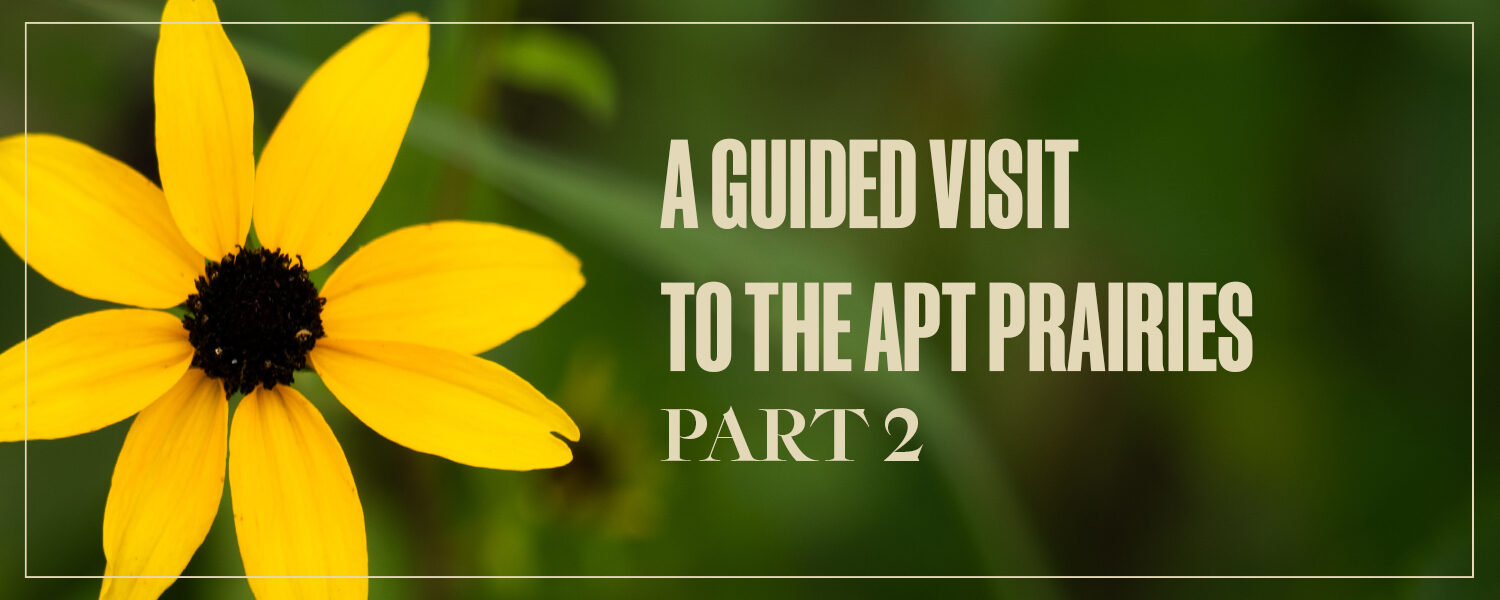Contact Us
American Players Theatre
5950 Golf Course Road
P.O. Box 819
Spring Green, WI 53588
(Map)
Box Office: 608-588-2361
Administration: 608-588-7401
Fax: 608-588-7085
American Players Theatre
5950 Golf Course Road
P.O. Box 819
Spring Green, WI 53588
(Map)
Box Office: 608-588-2361
Administration: 608-588-7401
Fax: 608-588-7085

More about the woods you play in each summer.
By Grace Vosen.
Every visit to APT starts with the landscape, whether it’s the walk up the Hill or a leisurely picnic on our verdant grounds. But much like works of theater, landscapes don’t all fit into a single category. There are many ways to describe the ecosystems you might find while playing in the woods this summer.
Part 1 of this series was a self-guided “noticing tour” of the sights, sounds, and history of APT’s 110 acres. Now, allow us to share some of our favorite stories from the land’s million-year history.
Here’s what you’re seeing when you visit this landscape:
1. The history of glaciers in Wisconsin.
Wisconsin has experienced three ice ages over geological history. The most recent of these is the familiar capital-I Ice Age. Geologists worldwide refer to one portion of the Ice Age as “the Wisconsin glaciation” because its effects can be seen so easily in our state.
None of the glaciers during any of these ice ages reached APT’s corner of southwestern Wisconsin. Our region is known as the Driftless Area because of the lack of glacial debris, which is called drift. While other parts of Wisconsin were flattened or re-shaped by the massive glaciers, the Driftless has been relatively untouched for over a million years. It is truly an ancient landscape that inspires our work.
2. Spring Green’s location in the Wisconsin River valley
The sandy valley and steep sandstone hills around Spring Green are home to an ancient river system that includes the Wisconsin River as we know it today. On the hills north of the river, direct sunlight and sandy soil have created a microclimate known as “the Wisconsin Desert” where cacti and lizards thrive.
At APT, the sands are home to a variety of prairie plants that also thrive in dry conditions. The soils that were deposited over millions of years are still providing returns through our lovely flora.
3. The effects of fire and Indigenous land stewardship
Ten thousand years ago, a collection of grass and wildflower species became specially adapted to the conditions of the Midwest. This community of plants, along with the animals it supports, is what we call prairie. Prairies are open grasslands with very few trees (a good match for our sandy soil). Oak savanna, a related ecosystem, has scattered trees and historically made up a large portion of APT’s property.
Prairies and oak savannas have been maintained over the millennia through fire. This includes both wildfires and intentional fires set by Indigenous people. Many prairie plants are healthier and produce more viable seed if they’re regularly burned. As these fires have been drastically reduced over the last century, some of the diverse plant species that evolved here are now disappearing from existence.
4. Wisconsin’s legacy of conservation
Knowledge of the Driftless and other landscapes was being lost at an alarming rate by the time Wisconsin thinkers such as Aldo Leopold, Frank Lloyd Wright, and (later) Gaylord Nelson worked to conserve the natural world. Conservation champions from our state helped lay the foundation for the disciplines of ecology, environmental advocacy, and ecological restoration.
Aldo Leopold especially called for a new way of thinking, a land ethic that “changes the role of Homo sapiens from conqueror of the land-community to plain member and citizen of it.” As with creating art, we must use our hearts as well as our minds to guide our decisions about the land entrusted to us.
5. Hope for the future
As we tell stories on stage, we also hope to tell our story through how we care for the land. We are working to restore vulnerable species and ecosystems at APT, thanks to our Green Sponsors and Green Volunteers who support us and contribute their time. We hope that the next time you grace us with your presence, you’ll feel you know our native landscapes a little bit better!